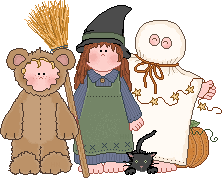|

What is Halloween ?
Halloween or Hallowe'en is a holiday on the
evening of October 31 that is celebrated in North America and in some
areas of Western Europe.
The eve is that before All Saints' Day, November 1— hence its alternative
name: All Saints' Eve or All Hallows' Eve. All Saint's Day is a holy day
in Catholic tradition that was established in 9th century to honor all the
Christian saints.
Not like All Saint's Day, Halloween is based
around embracing scary things, particularly those involving death, the
undead, "evil" magic, and mythical monsters. It is a liminal or threshold
occasion, when the distinctions between the daylight world of reason and
the spectral nightworld are blurred.
Various traditions, and indeed even to this
day people of different religious persuasions, celebrate "Halloween" in
quite different ways. Certain customs long surviving in Ireland, were
brought to the United States by Irish emigrants in the 19th century.
The origin of Halloween might be from Samhain,
a Celtic holiday. The ancient Celts, which are people who lived in most of
Western and Central Europe at 1000 BC, marked the end of harvest season
and the beginning of winter by celebrating this holiday which took place
each year at the night of October 31. After the crops were harvested,
Druids in Ireland and Britain would light fires and offer sacrifices of
crops and animals. As they danced around the fires, the season of the sun
passed and the season of darkness began. When the morning of November 1
arrived, the Druids would give an ember from their fires to each family
who would then take them home to start new cooking fires. These fires were
believed to keep the homes warm and free from evil spirits, as it was
considered a time of year when the veils were thin between worlds. A
three-day festival called Samhain (pronounced "sow-inn") followed. In
Ireland it was believed to be the night on which the invisible "gates"
between this world and the Other World were opened and free movement
between both worlds was possible. In the Other World lived the immortal "Sidhe"
(pronounced "shee"), the female members of whom were called beán sidhe or
banshees. lived in most of
Western and Central Europe at 1000 BC, marked the end of harvest season
and the beginning of winter by celebrating this holiday which took place
each year at the night of October 31. After the crops were harvested,
Druids in Ireland and Britain would light fires and offer sacrifices of
crops and animals. As they danced around the fires, the season of the sun
passed and the season of darkness began. When the morning of November 1
arrived, the Druids would give an ember from their fires to each family
who would then take them home to start new cooking fires. These fires were
believed to keep the homes warm and free from evil spirits, as it was
considered a time of year when the veils were thin between worlds. A
three-day festival called Samhain (pronounced "sow-inn") followed. In
Ireland it was believed to be the night on which the invisible "gates"
between this world and the Other World were opened and free movement
between both worlds was possible. In the Other World lived the immortal "Sidhe"
(pronounced "shee"), the female members of whom were called beán sidhe or
banshees.
Bonfires played a large part in the
festivities and hundreds of fires are lit each year in Ireland on
Halloween night. Villagers cast the bones of the slaughtered cattle upon
the flames. The word "bonfire" is thought to derive from "bone fires."
With the bonfire ablaze, the villagers extinguished all other fires. Each
family then solemnly lit their hearth from the common flame, thus bonding
the families of the village together.
Like most Celtic festivals, Samhain was
celebrated on a number of levels. Materially speaking it was the time for
gathering in food for the long winter months ahead, bringing people and
their livestock in to their winter quarters. To be alone and missing at
this dangerous time was to expose yourself and your spirit to the perils
of imminent winter. In present times the importance of this part of the
festival has diminished for most people.

[ Back to Halloween Menu
]
[ Back to Holidays Land
]
[ Back to Our Home
]
Page created: Sep 7, 2004
Last updated: Sep 7, 2004
Information is from
Wikipedia,
Encarta.
Graphics are from
Graphics by
Irene, Ritva's
Gallery,
Graphic Garden.
|